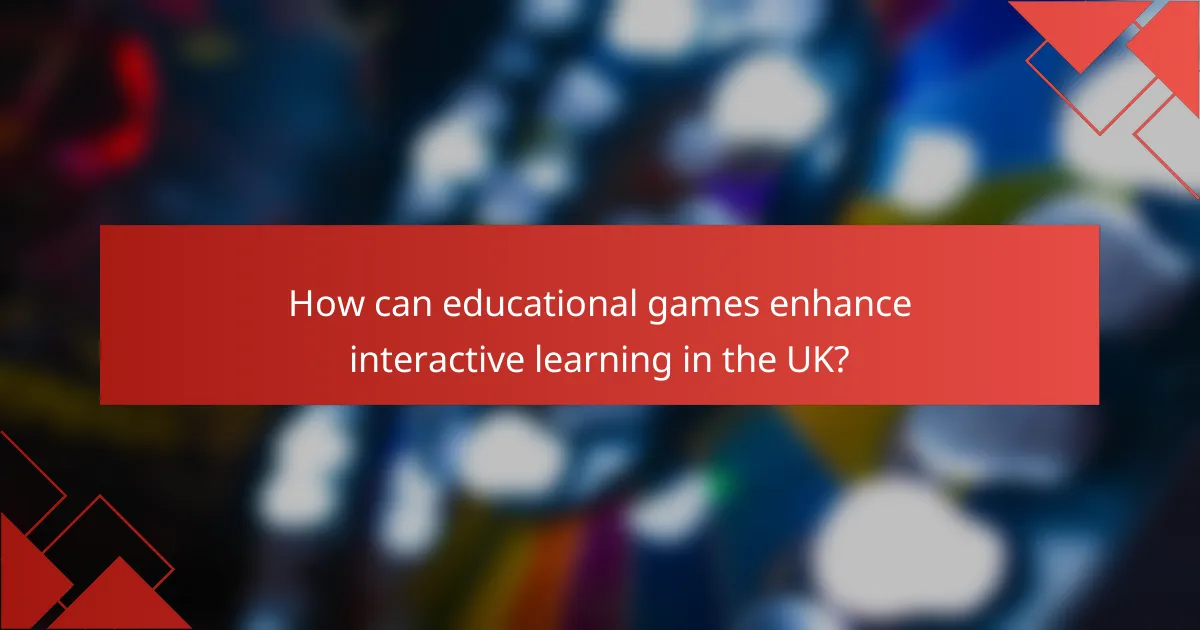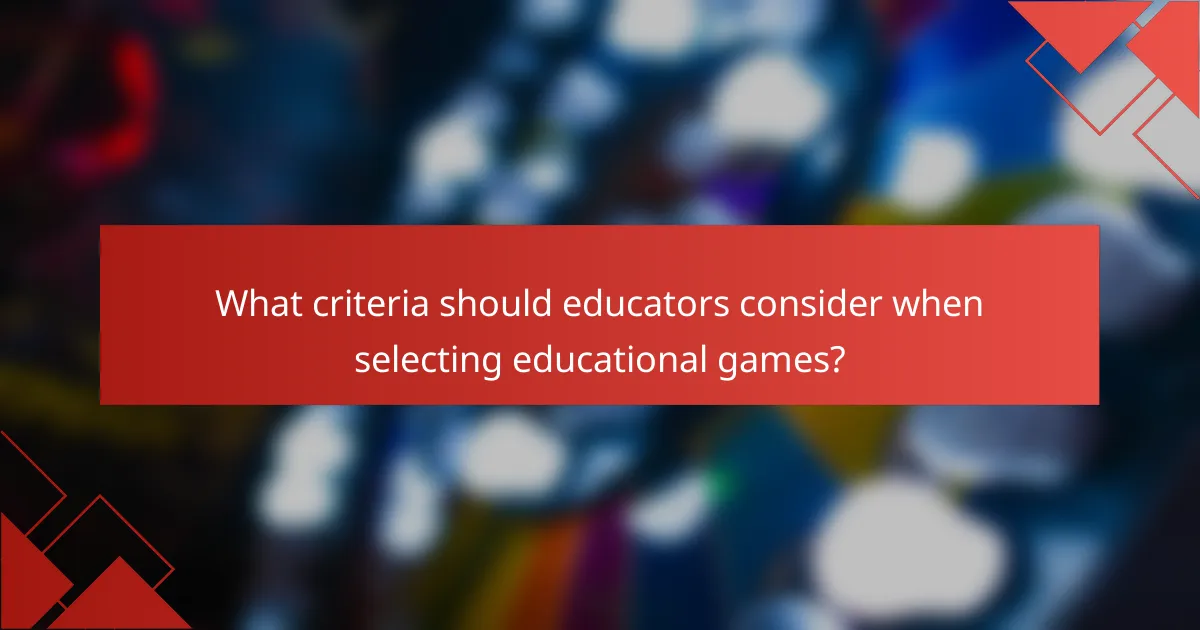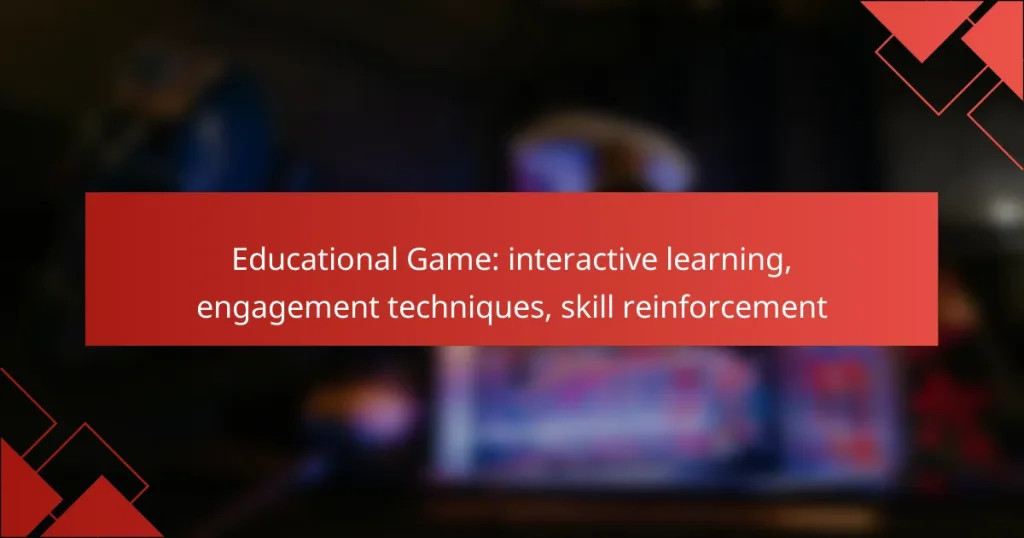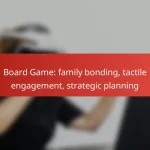Educational games play a crucial role in enhancing interactive learning by fostering engagement and providing personalized experiences for students. Through immersive environments and enjoyable activities, these games reinforce essential skills such as critical thinking, problem-solving, and teamwork, making the learning process both effective and enjoyable.

How can educational games enhance interactive learning in the UK?
Educational games significantly enhance interactive learning in the UK by fostering engagement and enabling personalized experiences. These games create immersive environments where students can actively participate, reinforcing skills through enjoyable, hands-on activities.
Increased student engagement
Educational games capture students’ attention and maintain their interest, making learning more appealing. By incorporating elements like competition, rewards, and storytelling, these games motivate learners to participate actively, which can lead to improved retention of information.
For instance, games that involve problem-solving or collaborative tasks encourage teamwork and communication, essential skills in today’s educational landscape. Teachers can implement game-based learning in various subjects, from mathematics to history, to keep students engaged.
Personalized learning experiences
Educational games allow for tailored learning experiences that cater to individual student needs. Players can progress at their own pace, enabling them to master concepts before moving on to more challenging material.
Many games adapt their difficulty based on the player’s performance, providing a customized approach that can help struggling students catch up while also challenging advanced learners. This adaptability is crucial in a diverse classroom setting, ensuring that all students can benefit from the learning experience.
Real-time feedback mechanisms
One of the key advantages of educational games is their ability to provide real-time feedback. Students receive immediate responses to their actions, allowing them to understand their mistakes and learn from them without delay.
This instant feedback loop helps reinforce learning concepts and encourages students to try again, fostering a growth mindset. Educators can leverage this feature to track progress and identify areas where students may need additional support, making it easier to adjust teaching strategies accordingly.

What are effective engagement techniques for educational games?
Effective engagement techniques for educational games include gamification elements, storytelling approaches, and collaborative gameplay. These strategies enhance user interaction, motivation, and skill reinforcement, making learning more enjoyable and impactful.
Gamification elements
Gamification involves integrating game-like features into educational content to boost engagement. Common elements include points, badges, leaderboards, and challenges that reward users for their progress and achievements. These features can motivate learners by providing clear goals and a sense of accomplishment.
When implementing gamification, consider balancing competition and collaboration. Too much focus on competition may discourage some learners, while collaborative elements can foster a supportive learning environment. Aim for a mix that suits your target audience.
Storytelling approaches
Storytelling in educational games creates a narrative that captivates players and makes learning more relatable. By embedding educational content within a compelling story, players are more likely to engage with the material and retain information. This technique can involve characters, plots, and settings that resonate with the learners’ experiences.
To effectively use storytelling, ensure that the narrative aligns with the educational objectives. Use relatable scenarios and challenges that encourage critical thinking and problem-solving. This approach not only enhances engagement but also helps learners connect emotionally with the content.
Collaborative gameplay
Collaborative gameplay encourages players to work together to achieve common goals, fostering teamwork and communication skills. This technique can be particularly effective in educational settings, as it allows learners to share knowledge and support each other’s learning processes.
When designing collaborative elements, consider incorporating tasks that require group problem-solving or discussions. This can include team challenges or projects that necessitate input from all participants. Ensure that roles within the collaboration are clear, so each player knows how they contribute to the group’s success.

What skills can be reinforced through educational games?
Educational games can effectively reinforce a variety of skills, including critical thinking, problem-solving, and teamwork. These games engage learners in interactive experiences that promote active participation and skill development.
Critical thinking skills
Critical thinking skills involve analyzing information, evaluating evidence, and making reasoned decisions. Educational games often present players with scenarios that require them to assess situations, weigh options, and draw conclusions based on available data.
For example, strategy-based games challenge players to consider multiple variables and potential outcomes before making a move. This process enhances their ability to think logically and critically under pressure.
Problem-solving abilities
Problem-solving abilities are essential for navigating challenges and finding effective solutions. Educational games frequently incorporate puzzles or obstacles that players must overcome, fostering a mindset geared towards exploration and innovation.
Games that require players to devise strategies or troubleshoot issues help reinforce these skills. For instance, a game that simulates real-world challenges can encourage players to think creatively and adapt their approaches based on trial and error.
Teamwork and collaboration
Teamwork and collaboration are vital skills in both academic and professional settings. Many educational games are designed to be played in groups, promoting communication and cooperation among participants.
In multiplayer games, players must work together to achieve common goals, which enhances their ability to share ideas, delegate tasks, and resolve conflicts. This collaborative environment can mirror real-life situations, making the learning experience more relevant and impactful.

What criteria should educators consider when selecting educational games?
Educators should consider alignment with curriculum standards, age appropriateness, and accessibility features when selecting educational games. These criteria ensure that the games effectively enhance learning while being suitable for the intended audience.
Alignment with curriculum standards
When selecting educational games, it’s crucial to ensure they align with relevant curriculum standards. This alignment guarantees that the content supports learning objectives and meets educational requirements set by local or national authorities.
For example, a game designed to teach basic math skills should correspond to the math standards outlined for a specific grade level. Educators can review the game’s educational goals and compare them with the curriculum to confirm compatibility.
Age appropriateness
Age appropriateness is essential for maintaining student engagement and ensuring effective learning. Games should be designed for the cognitive and emotional development of the target age group, avoiding content that may be too complex or too simplistic.
For instance, a game aimed at early elementary students should feature simple language and concepts, while a game for high school students can incorporate more advanced topics. Educators should evaluate the game’s content, language, and complexity to ensure it matches the intended age group.
Accessibility features
Accessibility features are vital for ensuring that all students can participate in educational games. Games should include options for different learning needs, such as audio descriptions, text-to-speech, and adjustable difficulty levels.
Educators should look for games that comply with accessibility standards, such as WCAG (Web Content Accessibility Guidelines), to ensure inclusivity. Providing options for students with disabilities can enhance engagement and learning outcomes for everyone.

How do educational games compare to traditional learning methods?
Educational games often provide a more engaging and interactive experience compared to traditional learning methods. They foster active participation, which can lead to better understanding and skill reinforcement.
Interactive vs. passive learning
Interactive learning through educational games allows students to actively engage with the material, making decisions and solving problems in real-time. In contrast, traditional methods often rely on passive absorption of information, such as listening to lectures or reading textbooks.
This active involvement can enhance critical thinking and creativity, as learners are encouraged to explore concepts rather than simply memorize facts. For example, a math game that requires players to solve puzzles fosters deeper understanding compared to rote memorization of formulas.
Engagement levels
Educational games typically achieve higher engagement levels by incorporating elements like competition, rewards, and immediate feedback. These features motivate learners to participate and persist through challenges, which is often lacking in conventional classroom settings.
In traditional learning, students may feel less inclined to engage due to a lack of interactive elements. For instance, a science experiment conducted in a game format can captivate students’ attention far more effectively than a lecture on the same topic.
Retention of information
Retention of information tends to be higher with educational games as they often utilize repetition and reinforcement in a fun context. When learners are actively involved in the learning process, they are more likely to remember the material long-term.
Research suggests that students who engage in game-based learning can retain information significantly better than those who rely solely on traditional methods. For example, a language learning app that incorporates games can help users remember vocabulary more effectively than flashcards alone.

What are the best educational games available in the UK?
Some of the best educational games in the UK include Kahoot! and Prodigy Math, both designed to enhance learning through interactive engagement. These platforms focus on reinforcing skills in a fun and motivating way, making education more enjoyable for students.
Kahoot!
Kahoot! is a game-based learning platform that allows educators to create quizzes and interactive games for students. Users can participate in real-time, answering questions on their devices, which fosters engagement and competition.
To get started, teachers can sign up for a free account and create quizzes tailored to their curriculum. It’s essential to ensure that questions are clear and relevant to maximize learning outcomes. A common pitfall is making quizzes too long, which can lead to disengagement.
Prodigy Math
Prodigy Math is an adaptive math game that aligns with the UK curriculum, allowing students to practice math skills in a fantasy-based environment. Players solve math problems to progress through the game, making it an effective tool for skill reinforcement.
Teachers can monitor student progress through detailed reports, which helps identify areas where students may need additional support. It’s advisable to encourage regular play, as consistent practice can significantly improve math proficiency. Avoid overwhelming students with too many complex concepts at once to maintain their interest and motivation.


